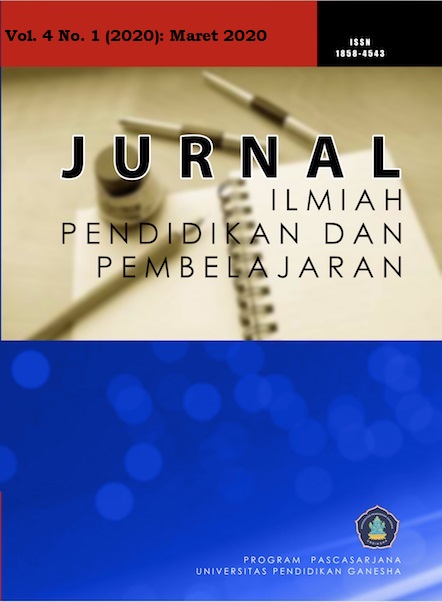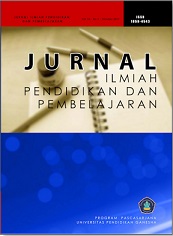The Validity and Practicality of the Chemistry Learning Device by Using STEM-PjBL Model
DOI:
https://doi.org/10.23887/jipp.v4i1.24150Abstract
The purpose of this research was to produce the valid and practical learning device using STEM-PJBL to be applied in the chemistry class of Senior High School. The Research was conducted based on the steps of development research according to Borg and Gall. The students of the research included lesson plan, student worksheet, teaching material and evaluation instrument; while the objects of the research were validity and practically of the learning devices themselves. The research was conducted at SMA Negeri 1 Kuta Selatan in March to April 2019, by envolving the XI grade science students as the research population. The data retrieval used validity sheet that was taken by the expert, readability test sheet by teachers and students and students response questionaire about the learning process. The result of the research showed the content of lesson plan as 1, student worksheet as 0,875; material text as 0,80 and evaluation instrument as 0,97; so that all were categorized as valid. The practically score based on the readability of lesson plan as 3,78; student worksheet as 3,68; material text as 3,83; and evaluation instrument as 3,64 ; all were categorized very practical. The practically score of learning device based on the sudents response during the learning process on initial field test was as 4,59 (very practical) and on the main field test was 4,24 (very practical). Therefore, the STEM-PJBL produced in this reseach was categorized in very valid and very practical.
Keywords: Learning devices, STEM-PJBL Model, Chemistry, validity and practicality
References
Afriana, J., Fitriani, A., & Permanasari, A.. 2016. Penerapan Project Based Learning Terintegrasi STEM untuk Meningkatkan Literasi Sains Siswa Ditinjau dari Gender. Jurnal Inovasi Pendidikan IPA, 2 (2), 202 – 212. Tersedia pada http://uny.ac.id/index.php/jipi. Diakses 9 Nopember 2018.
Borich, G. D. 1994. Observation Skill for Effective Teaching. New York: Mac Millian Publishing Company.
Borg, W. R. & Gall, M. D. 1989. Educational Research. Fifth Edition. New York: Longman.
BSNP. 2010. Paradigma Pendidikan Nasional Abad XXI.
Capraro, R. M., Capraro, M. M., & Morgan, J. R., 2013. STEM Project-Based Learning: An Integrated Science, Technology, Engineering, and Mathamatics (STEM) Approach (second ed). Rotherdam: Sense Publishers.
Capraro, R. M., Capraro, M. M., & Sunyoung, H., 2015. How Science, Technology, Engineering, and Mathematics (STEM) Project-Based Learning (PBL) Affects High, Middle, and Low Achievers Differently: The Impact of Student Factors on Achievement. International Journal of Science and Mathematics Education, pp. 1-25.
Diaz, D., & King, P. (2007). Adapting a Post-Secondary STEM Instructional Model to K-5 Mathematics Instruction. Clemson: Clemson University.
Dyer, J. H., Gregersen, H. B., & Cristensen, C. M., 2009. Five Discovery Skills that Distinguish Great Innovators. Harvard Business School.
Gregory, R.J. 2000. Psychological Testing: History, Principles, and Applications. Boston: Allyn and Bacon.
Hake R.R. 1999. Analyzing Change/Gain Scores. Tersedia pada http://www.physics.indiana.edu/ /Analyzingchange-Gain.pdf (diakses 9 Pebruari 2019)
Heinich, R., Molenda, M., Russell, J., & Smaldino, S., 1996. Instructional Media and Technologies for Learning (5 ed). New Jersey : Simon & Schuster Company Engelewood Cliffs.
Ismayani, A. 2016. Pengaruh Penerapan STEM Project Based Learning Terhadap Kreativitas Matematis Siswa SMK. Journal of Mathematics and Education, 3 (4).
Katz, I. R., & Macklin, A. S. 2007. Information and Communication Technology (ICT) Literacy: Integration and Assessment in Higher Education. Systemics, Cybernetics and Informatics, 5(4), 50-55. Tersedia pada: http://www.iiisci.org/Journal/CV$/sci/pdfs/P890541.pdf.
KBBI. Pengertian Model Pembelajaran STEM-PjBL. Tersedia pada: https://kbbi.web.id. Diakses pada 9 November 2018.
Kemendikbud. 2013. Kerangka Dasar Kurikulum 2013. Kementerian Pendidikan dan Kebudayaan Direktorat Jenderal Pendidikan Dasar: Jakarta.
Kornelia, D. K., Mayasari, T., dan Kurnadi, E., 2017. Pengaruh Pembelajaran STEM-PjBL terhadap Keterampilan Berpikir Kreatif. E-journal.UNIPMA III: 266 – 274. Tersedia pada http://e-journal.unipma.ac.id/index.php/snpf. Diakses tanggal 3 Maret 2019.
Laboy-Rush, D. 2010. Integrated STEM Education Through Project-Based Learning. www.learning.com/stem/whitepaper/integrated-STEM-through-Project-based-Learning
Linn, R.L. 1989. Educational Measurement. (3rd Ed.). New York: Macmillan Publishing Company.
Majid, A. 2009. Perencanaan Pembelajaran Mengembangkan Standar Kompetensi Guru. Bandung: PT Remaja Rosdakarya.
Nichols, J. 2013. 4 Essential Rules of 21st Century Learning. [Online]. Tersedia di: http://www.teachthought.com/learning/4-essential-rules-of-21stcentury-learning/. Diakses 19 Nopember 2018.
Nunamaker, J.F., Chen, M., & Purdin, T. D. M., 1991. System Development in Information Systems Research. Journal of Management Information Systems, 7(3), 89-101.
OECD. 2014. PISA 2012 Resultsin Focus: What15-year-oldsknowandwhat they can do with what they know.
OECD. 2016. PISA 2015 Result in Focus-OECD.org.
Padmo, D., Belawati, T., dan Purwanto. 2004. Teknologi Pembelajaran (Peningkatan Kualitas Belajar Melalui Teknologi Pembelajaran). Jakarta: Pustekkom.
Pannen, P., dan Purwanto. 1995. Penulisan Bahan Ajar. Dalam Mengajar di Perguruan Tinggi Bagian Empat Program Applied Approach. Proyek Pendidikan Tenaga Guru Dirjen Dikti Depdikbud.
Peffers, K., Tuunanen, T., Rothenberger, M. A., & Chatterjee, S., 2007. A Design Science Research Methodology for Information Systems Research. Journal of Management Information Systems, 24(3), 45-77.
Permanasari, A. 2016. STEM Education: Inovasi dalam Pembelajaran Sains. Prosiding Seminar Nasional Pendidikan Sains (SNPS) 2016. Bandung: Universitas Pendidikan Indonesia.
Permendikbud. 2016. Salinan Lampiran Peraturan Menteri Pendidikan dan Kebudayaan Nomor 22 Tahun 2016 Tentang Standar Proses Pendidikan Dasar dan Menengah. Jakarta: Kementerian Pendidikan dan Kebudayaan. Tersedia pada: http://bsnp-indonesia.org/id. Diakses pada 9 November 2018.
Retnawati, H. 2015. Akurasi Instrumen Skala Likert dan Pilihan Ganda untuk Mengukur Self Regulated Learning. Laporan Penelitian. Tidak Dipublikasikan.
Retnawati, H. 2015. Analisis Kuantitatif Instrumen Penelitian. Yogyakarta: Parama
Ridwan, A.S., Sondang, R. M., Hary, S., Sudiran. 2018. Penelitian Pendidikan. Tanggerang: Tira Smart.
Sadjati, I. M. 2012. Pengembangan Bahan Ajar. In: Hakikat Bahan Ajar. Universitas Terbuka, Jakarta, pp. 1-62. ISBN 9790110618. http://repository.ut.ac.id/id/eprint/4157. Diakses 13 Januari 2019.
Sahin, A., & Top, N., 2015. STEM Student on The Stage (SOS): Promoting Student Voice and Choiche in STEM Education Through an Interdisciplinary, Standars-Focused, Project Based Learning Approach. Journal of STEM Education, Innovations and Research, 16(3), 22 – 33.
Santyasa, I W. 2014. Asesmen dan Evaluasi Pembelajaran Fisika. Yogyakarta: Graha Ilmu.
Satchwell, R.E., & Loepp, F. L., 2002. Designing and Implementing an Integrated Mathematics, Science, and Technology Curriculum for the Middle School. Journal of Industrial Teacher Education, 39(3). http://scholar.lib.vt.edu/ejournals/JITE/v39n3/satchwell.html.
Stiggins, R. J. 1994. Student-Centered Classroom Assessment. New York: Macmillan College Publishing Company.
Sudijono, A. 2011. Pengantar evaluasi pendidikan. Jakarta: Rajagrafindo Persada.
Sudjana, N. 2005. Dasar-Dasar Proses Belajar Mengajar. Bandung: Sinar Baru Algensindo.
Sugiyono. 2009. Metode Penelitian Bisnis (Pendekatan Kuantitatif, Kualitatif, dan R&D). Bandung: Alfabeta.
Sukmadinata, N. S. 2010. Metode Penelitian Pendidikan. Bandung: Remaja Rosdakarya.
Suryana, A., Utami, I. S., Septiyanto, R. F., dan Wibowo, F. C., 2017. Pengembangan STEM-A Berbasis Kearifan Lokal dalam Pembelajaran Fisika. Jurnal Ilmiah Pendidikan Fisika Al-BiRuNi, 06 (1) (2017) 67 – 73. Diakses pada 28 Pebruari 2019.
Sutrisno, H. 2004. Metodologi Research. Yogyakarta: Andi Offset.
Syafura, D. T., & Bunawan, S. W. 2017. The Effect of Scientific Inquiry Model Assisted Visual Media on Students’ Conceptual and Procedural Knowledge. American Journal of Educational Research. 5(6).623-628. Tersedia pada: http://pubs.sciepub.com. Diakses 9 November 2018.
Thiagarajan, et al. 1974. Instructional Development for Training Teachers of Exceptional Children. Washinton DC: National Centre for Improvement Educational System.
Tretten, R., & Zachariou, P. 1997. Learning about Project-Based Learning: Assessment of Project-Based Learning in Tinkertech Schools.
Trianto, 2007. Model-Model Pembelajaran Inovatif Berorientasi Kontruktivistik. Prestasi Pustaka: Jakarta.
Trilling, B., & Fadel, C., 2009. 21st Century Skills Learning For Life In Our Times. USA: HB Printing.
Tseng, K. H., Chang, C. C., Lou, S. J., & Chen, W. P., 2013. Attitudes Towards Science, Technology, Engineering and Mathematics (STEM) in a Project Based Learning (PjBL) Environment. International Journal Technology and Design Education vol 23:87–102
Widoyoko, S. E. P. 2009. Evaluasi Program Pembelajaran. Yogyakarta: Pustaka Pelajar.
Wiggins, G. P., & McTighe, J. 1998. Understanding by Design. Alexandria, VA: Association for Supervision and Curriculum Development.
Downloads
Published
How to Cite
Issue
Section
License
Authors who publish with the Jurnal Ilmiah Pendidikan dan Pembelajaran (JIPP) agree to the following terms:
- Authors retain copyright and grant the journal the right of first publication with the work simultaneously licensed under a Creative Commons Attribution License (CC BY-SA 4.0) that allows others to share the work with an acknowledgment of the work's authorship and initial publication in this journal.
- Authors are able to enter into separate, additional contractual arrangements for the non-exclusive distribution of the journal's published version of the work (e.g., post it to an institutional repository or publish it in a book), with an acknowledgment of its initial publication in this journal.
- Authors are permitted and encouraged to post their work online (e.g., in institutional repositories or on their website) prior to and during the submission process, as it can lead to productive exchanges, as well as earlier and greater citation of published work. (See The Effect of Open Access)










